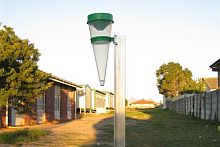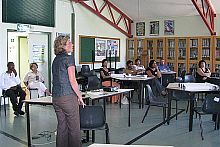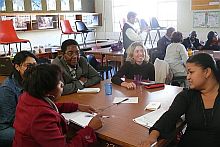SAEON primes teachers to develop scientific enquiry skills in learners
|
Changing weather patterns — from dwindling ice cover in Alaska to severe droughts and water shortage in some African countries — have a major impact on our planet’s plant and animal species. They serve as a constant reminder that our climate is changing.
In an effort to make our young generation aware of the change in weather patterns, SAEON’s Education Outreach programme has introduced a weather monitoring programme at specially selected schools in the vicinity of its nodes.
This year SAEON’s Fynbos Node is presenting a series of weather-monitoring workshops geared at improving science knowledge and skills for both teachers and learners. The teachers’ participation is expected to lead to the development of hands-on science projects and activities at the schools.
New scientific skills for learners
Learners will be taught how to track data for their school on a continuous basis, and record daily variations in wind speed and direction, air pressure and humidity,as well as temperature and rainfall. They will learn to interpret, analyse and generate information from quantitative measurements, which can be easily integrated across all learning areas in a school syllabus.
Four workshops for teachers have so far been held in collaboration with the South African Weather Services and a fifth workshop focused on teachers developing a hands-on science activity. Based on consultations with teachers, SAEON supplied weather monitoring equipment such as rain gauges and thermometers to the schools. Data from these instruments will be used in formulating hands-on science activities for the learners.
At the workshops Lynette van Schalkwyk, Senior Forecaster for SA Weather Services in Cape Town and fellow forecasters Stella Nake and Johan Singleton provided information on the South African weather, weather monitoring instruments and their use, temperature and precipitation. This information will enable the teachers to breathe life into text-book learning by devising practical activities for their learners.
Educators from Excelsior, Kasselsvlei, Silversands and Settlers high schools who attended the workshops have all expressed enthusiasm for the project. In the words of Mr PJ Williams, a senior teacher at Excelsior High: “This is what our learners need. We need to translate what the curriculum prescribes into the learners’ local context. The study of weather is relevant to the areas where they live, and hopefully the activities that we design will make the study of science simple and easy for them. Interventions such as the SAEON programme add value to our schools.”
Aligning weather monitoring with the school syllabus
Based on the workshops, the teachers agreed on the knowledge required for weather monitoring at the schools, the skills that could be acquired by both teachers and learners and the support required by teachers. The workshops enabled teachers to assess their prior knowledge of weather monitoring, how the proposed weather-monitoring project can be aligned with the school syllabus and which learning areas are affected. They identified learning areas as well as learner activities, with engagements around mathematics, science and geography receiving most of the attention.
The teachers moreover developed an action plan for weather monitoring at their schools. In the workshops they learnt how to make wind direction instruments using a broom stick, flag material and direction coordinates painted on rocks which are placed at the base of the stick to indicate wind direction. These have now been installed at their schools.
The first workshop was held at the Environmental Education Resources Unit at the University of Western Cape, the second at Settlers High School, the third at Kasselsvlei High School and the fourth at Silversands High School.
The fifth workshop, at Excelsior High, focused on developing hands-on activities for the learners using the data from the measuring instruments supplied to the schools and the information supplied by SA Weather Services experts.
The teachers suggested that these activities could be used to develop learners’ skills in observation, recording, analyses, communication and decision-making.
SAEON’s Education Outreach Coordinator, Sibongile Mokoena attended the third workshop and provided some expert guidance with regard to the school programme.







